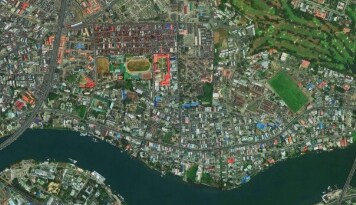Nigerian satellites could hold the key to aviation safety globally – NASDRA

Nigerian Satellite (NigeriaSat-1)
The story of Nigeria’s venture into space began in 2003 when its first satellite, NigeriaSat-1 was built by UK-based Surrey Space Technology (SST) and launched into space in a Russian spaceport. NigeriaSat-1 costs the Nigerian government about $13 million USD.
In 2004, NigeriaSat-1 came into limelight when it provided images during the Indian Ocean Tsunami, but more importantly, in 2005 when the famous natural disaster Hurricane Katrina struck the Eastern coast of the United States of America, NigeriaSat-1 was the first space-based asset to provide extensive pictures and environmental data on the incident. These services were rendered free of charge by the Nigerian authorities.
NigeriaSat-2 and NigeriaSat-X
Three of these type of orbitals is currently being used in Nigeria to collect terrestrial data from its low orbit, critical information needed for disaster management, infrastructural planning and even a possible military application. NigeriaSat-1 was de-orbited in 2012 after exhausting its useful shelf life, it was quickly replaced by NigeriaSat-2 and NigeriaSat-X both built by the same company SST. NigeriaSat-X was designed in SST’s facility in the United Kingdom by Nigerian Engineers and is an integral section of the International Disaster Monitoring Constellation (IDMC) coordinated by SST.
NigComSat-1
To further consolidate on its achievements, a Chinese-built communications satellite, NigComSat-1 was launched in China in 2007 for Nigeria unfortunately, it was lost due to a malfunction in its solar array assembly which resulted in power failures. In 2011, the lost satellite was replaced by NigComSat-1R which is currently used for broadcast and internet services in and around Nigeria.
The Nigerian Space Research and Development Agency (NASDRA) – the agency in-charge of coordinating all Nigerian space activities claims that its constellation of satellites could be the hub for out-of-space monitoring and tracking of aviation globally. The agency believes that it has the capability to locate any airborne plane within and outside Nigeria.
While speaking concerning this development, professor Mohammed Seidu, the Director General at NASDRA said Nigeria’s nano satellites are equipped with modern tracking technologies of airspace [sic]. He also revealed that the orbiting satellites have been connected with the ground receiving station which is located in Florida but was designed and built by Nigerian engineers.
NigeriaSat-X a Nano satellite weighing less than 500kg (1,102 pounds) was fully designed and constructed locally could have easily been used to locate the Malaysian airplane which went missing en route from Kuala Lumpur to Beijing in March 2014 with 239 people on board.
The DG of NASDRA was quoted saying, “with the nano-satellite, every aircraft within a particular location above us is located, through a special antenna which servers as base station. From the aircraft position, we navigate all the airspace via this antenna, while the ground station also gives accurate data of every air traffic to the control systems. That is why it helps us keep a surveillance of every aircraft that fliers above the airspace.”
With such capability, every airborne aircraft in all location around the world could be monitored. Prof. Seidu also made known that his agency’s technology can calculate the date, time an aircraft entered Nigerian airspace. Additionally, other valuable information usually needed for airspace monitoring like aircraft speed, distance, destination, altitude and even the aircraft type can be worked out.
As with aerial navigation, Inertial Guidance System (INS) triangulate the quadrant of an aircraft’s X- and Y-planes to ascertain its current position, however, satellites do not necessarily need all those cumbersome processes but can still monitor aircraft’s position in real-time.
Presently, NASDRA is pursuing a partnership with the Nigerian Federal Aviation Authority to provide real-time and cost-effective way to manage the country’s airspace to that effect, the Nigerian Military have commissioned the Defence Space Administration Office Complex and the Defence Cyber Operations Centre, at Obasanjo Space Centre in Abuja to harness the military potentials the satellites offers.
However, some engineers at NASDRA have a contrary opinion that a nano-satellite can “see” all aircraft across the globe, engineer Alphonsus Ezeibe calls it an “exaggerated and unsubstantial claim” He is of the believe that monitoring and tracking of aircraft outside Nigeria’s airspace requires a network of radars. He stated that ”what is the size of a nano-satellite? If the satellite can do all that with its moderate cost, why would any country ever need a bigger satellite which costs a fortune?”
Ezeibe also advices that even though building and launching a satellite to solve domestic surveillance needs is a feat worth celebrating but people should not exaggerate and make bogus claims.
Kenya to launch home-made nano-satellite
Kenya, another African country which has in recent years been pushing to join the club of satellite owners is set to launch its own home-made nano-satellite. The new satellite would be designed by students and researchers from the University of Nairobi (UoN) in collaboration with the Italian Sapienza University and the Japanese Space Agency (JAXA). The nano-satellite is expected to cost Ksh100 million (about $1million USD).
Only time would tell if Nigeria’s tiny satellites could actually hold the key in solving one of earth’s greatest worries, aircraft safety.




